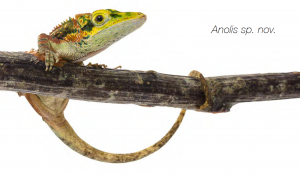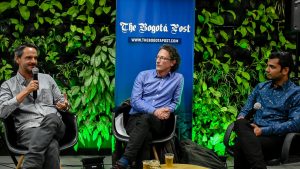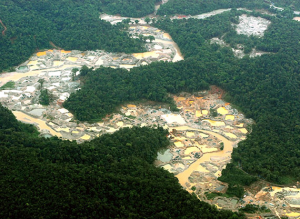
Newly found and as yet unnamed Anole Lizard in Santander. Photo courtesy of Expedición Colombia BIO
On Thursday night the Bogotá Post hosted an expert panel discussion at the Espacio Media Incubator in Medellín, in which leading environmental researchers discussed the numerous threats to Colombia’s biodiversity in the post peace agreement era. The implementation of the 2016 peace agreement has opened up vast areas of land, rich in biodiversity, which could now be exploited by a variety of groups for legal and illegal activities.
Speaking at the event were Dr. Nicolas Clerici, a landscape ecologist from Bogotá’s Rosario University, and Dr. Jesus A. Anaya from the Faculty of Engineering of Medellín University.
One of the evening’s main talking points was the rampant deforestation which has seen vast swathes of Colombian land stripped for logging, mining and in order to grow illegal crops. Dr. Anaya, who tracks deforestation using remote sensing technology and cloud computing, said that currently 200,000 hectares of land is used in Colombia for coca plantations. He added that a particularly high density of these crops are located on the Pacific Coast, many in areas with high levels of poverty where the State has no meaningful presence and coca farming provides armed groups with sizeable revenues to finance their activities.

From left to right: Dr. Jesus A. Anaya, Dr. Nicolas Clerici, and moderator Arjun Harindranath. online editor of The Bogotá Post. Photo by ESPACIO
Dr. Clerici spoke of two main threats biodiversity, the first being the distribution of land by illegal armed groups seeking to boost their social status among the local population in their areas of operation. The second threat comes for land-grabbing. In various parts of Colombia, dominant land owners are able to accumulate cheap land for mining, logging and farming, which not only accelerates deforestation but is also one of the main drivers of internal displacement in Colombia.
Both speakers stressed the far-reaching consequences of deforestation, which pose a serious threat to the biological corridors fuelling Colombia’s biodiversity. Dr. Clerici noted that Colombia is the second-most biodiverse country in the world and possesses a so-called “Megacorridor”, stretching from the Andes to the lowlands, which allows biodiversity to develop by providing a bridge for species to move across an enormous geographical area. Deforestation disrupts the gene connections which rely on biological corridors and thus significantly reduces the creation of new species.
Another major issue mentioned by Dr. Anaya is that of pollution. The professor said that large-scale mining projects frequently leave behind pools of water spread over hundreds of kilometres, contaminated with various chemicals such as mercury. This not only affects wildlife, but also the local population who use the pools for fishing.

The aftermath of mining activity, which frequently leaves behind contaminated pools. Photo courtesy of Dr. Jesus Anaya
Following the discussion on the main threats to biodiversity, the speakers outlined possible strategies for preventing the mass destruction of habitats.
Both agreed that the State needs to a establish a legitimate physical and legal presence in areas outside of the government’s sphere of influence, to stop land-grabbing and deforestation. Dr. Anaya argued that protected areas, for example national parks, require more assistance from state security forces to deal with threats from armed groups. Although several conservationist NGOs and IOs are present in Colombia, for security reasons there are some areas where they simply don’t go; this is where the State has to establish greater control and guarantee the protection of biodiversity.
Additionally, both panelists linked Colombia’s struggles to protect its ecological resources to the widespread poverty in areas with high deforestation rates. Dr. Clerici suggested that involving locals in the protection and management of natural resources could provide an economic incentive to protect land and simultaneously generate much-needed revenues in impoverished regions with few employment opportunities. Teaching people the value of environmental conservation, a complex issue difficult to explain to non-experts, would be a positive step in a country whose education system currently does not teach ecological issues.
Dr. Anaya mentioned the need to address cocaine demand, suggesting that efforts should be made to inform users of the disastrous effects that cocaine production has on forests and biodiversity.
With new president Iván Duque being sworn in just two days ago, neither Dr. Clereci nor Dr. Anaya could provide a clear picture of how biodiversity protection will pan out under the new administration. Dr. Clereci said he was pessimistic, an understandable viewpoint given the present scale of illegal activity. Thus, despite entering an era of relative peace, Colombia faces a tough battle to keep it biological corridors connected and to protect its richness in biodiversity.





